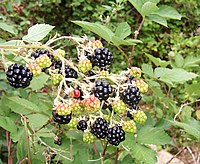
Photo from wikipedia
The present study has been undertaken to investigate the physico‐chemical, cooking qualities followed by proximate composition, phytochemical, and antioxidant properties of selected traditional and white rice varieties using standard procedures.… Click to show full abstract
The present study has been undertaken to investigate the physico‐chemical, cooking qualities followed by proximate composition, phytochemical, and antioxidant properties of selected traditional and white rice varieties using standard procedures. It was observed that Basmati rice showed the highest length, breadth, and L/B ratio compared to the traditional varieties. The traditional rice varieties especially Navara was found to be superior in terms of protein (9.61 ± 0.1%) with comparatively low carbohydrates than that of white rice varieties. White rice varieties showed better cooking properties with maximum water absorption index and water solubility index than the traditional rice varieties due to more starch content. The microstructure of traditional rice varieties was appeared to be pigmented due to the presence of anthocyanin with surface pores. The studies revealed that among traditional rice varieties Mapillai Samba has got the highest total phenols (290.70 ± 4.39 mg) and antioxidant activity (72.96 ± 3.34%) followed by anthocyanins and flavonoids. PRACTICAL APPLICATIONS: Traditional rice varieties were found to be rich in antioxidant, phytochemical, and nutritional properties than white rice. Mapillai Samba and Navara varieties were consumed in many parts of India for its nutritional significance. Traditional rice varieties can be efficiently processed into products like tart, cosmetics, red koji, colored noodles, cake, and preparation of yeast due to its medicinal values to cure stomach problems, bruised muscles, promote blood circulation, indigestion, and lower cholesterol level. Thus, traditional rice varieties can be incorporated along with the white rice varieties in new product development to enhance the nutritional status of the growing population to combat lifestyle disorders.
Journal Title: Journal of Food Process Engineering
Year Published: 2019
Link to full text (if available)
Share on Social Media: Sign Up to like & get
recommendations!